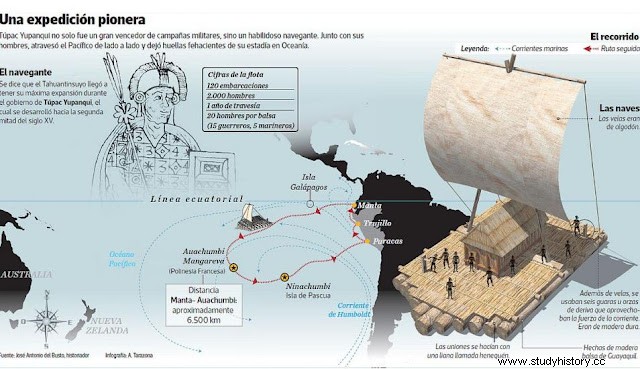“He [Túpac Yupanqui] was a man who had had nothing to do with the sea until he met it when he conquered the Gulf of Guayaquil [Ecuador], and discovered the rafts . [...] And also following the currents and the winds, he understood that they could reach anywhere,” the late historian José Antonio del Busto, author of the book “Tupac Yupanqui,” told El Comercio a few years ago. Discoverer of Oceania” –which brings together 30 pieces of evidence that would confirm the truth of this theory–.
 In the book “Túpac Yupanqui. Discoverer of Oceania", the late historian José Antonio del Busto collected 30 pieces of evidence that would confirm this theory.
In the book “Túpac Yupanqui. Discoverer of Oceania", the late historian José Antonio del Busto collected 30 pieces of evidence that would confirm this theory. —The explorer—
Túpac Yupanqui – Del Busto assured – conquered more than Alexander the Great. And after gaining control of Puná Island (Ecuador), which he reached by raft, he received news of the existence of two distant islands that housed a wide variety of resources:Auachumbi and Ninachumbi. The chroniclers Pedro Sarmiento de Gamboa, Martín de Murúa and Miguel Cabello de Balboa –who lived in the Viceroyalty of Peru in the 16th century– agree with this story.
With 120 boats and 2,000 men, the young prince –according to With the theory that Del Busto rescues, he began his adventure to these two islands, which would be Mangareva and Rapa Nui (Easter Island). He would also reach Nuku Hiva, in the Marquesas archipelago.
But what are the indications that support this proposal? In the first place, the chronicles indicate that after his trip, the Inca prince not only brought with him gold, silver, emeralds and rare animals, but also black slaves.
Since there is no record of explorations by Túpac Yupanqui to Africa, Del Busto claimed that they were slaves from Melanesia – another subregion of Oceania – who were on the aforementioned islands. Likewise, in Nuku Hiva, quipus –a tool for keeping accounts–, known in that place as quipona, were found.
—King Tupa—
For Joseph Dager, professor at the Antonio Ruiz de Montoya University and Del Busto's student, among the various indications that his professor collected about the Inca presence in Oceania, there are two that predominate. The first is the legend of King Tupa, which to this day remains on the island of Mangareva. The story tells of the arrival of this character in a fleet of pae pae, a sailing raft with a double mast, and that dazzled the natives with ceramics, since it was a pre-ceramic world; metals, because the locals were in the stone age, and textiles. It should be noted that the dance of King Tupa exists in this place.
The second important sign is in Rapa Nui, which houses a construction with Inca characteristics called Vinapú. “It is a construction in which they put stone on stone, and between these can not enter not a nail. This technique is seen in the Inca cities of Cusco", Dager points out. In this place, just as in Mangareva, there is a legendary character baptized as Mahuna-te Ra'á, which translates as "son of the Sun". For Del busto it was a reference to the Inca prince. He also relied on the existence of Quechua words in Rapa Nui. For example, the headdress worn by the island's famous monoliths is called puka, which means red in Quechua. There are also indications of travel between Moquegua and Pascua.
—The mission to Australia that left Callao—
Among the first recorded western explorations to Australia, there is one that left the port of Callao in 1605. The mission was commanded by Luis Vaz de Torres, a Spanish-Portuguese navigator. He crossed the strait between Australia and New Guinea, which now bears his name. In the San Pedrico, a 40-ton vessel, he traveled the Australian coast for three months. For more than 2 months, the Spanish sailed along the coast of New Guinea, which they claimed for Philip III, fighting with the natives and capturing some. On May 22, 1607, Torres arrived in Manila, the capital of the Philippines, where he disappeared from history, according to the Australian Dictionary of Biography.
Source: https://elcomercio.pe
José Antonio del Busto:Tupac Yupanqui, discoverer of Oceania
